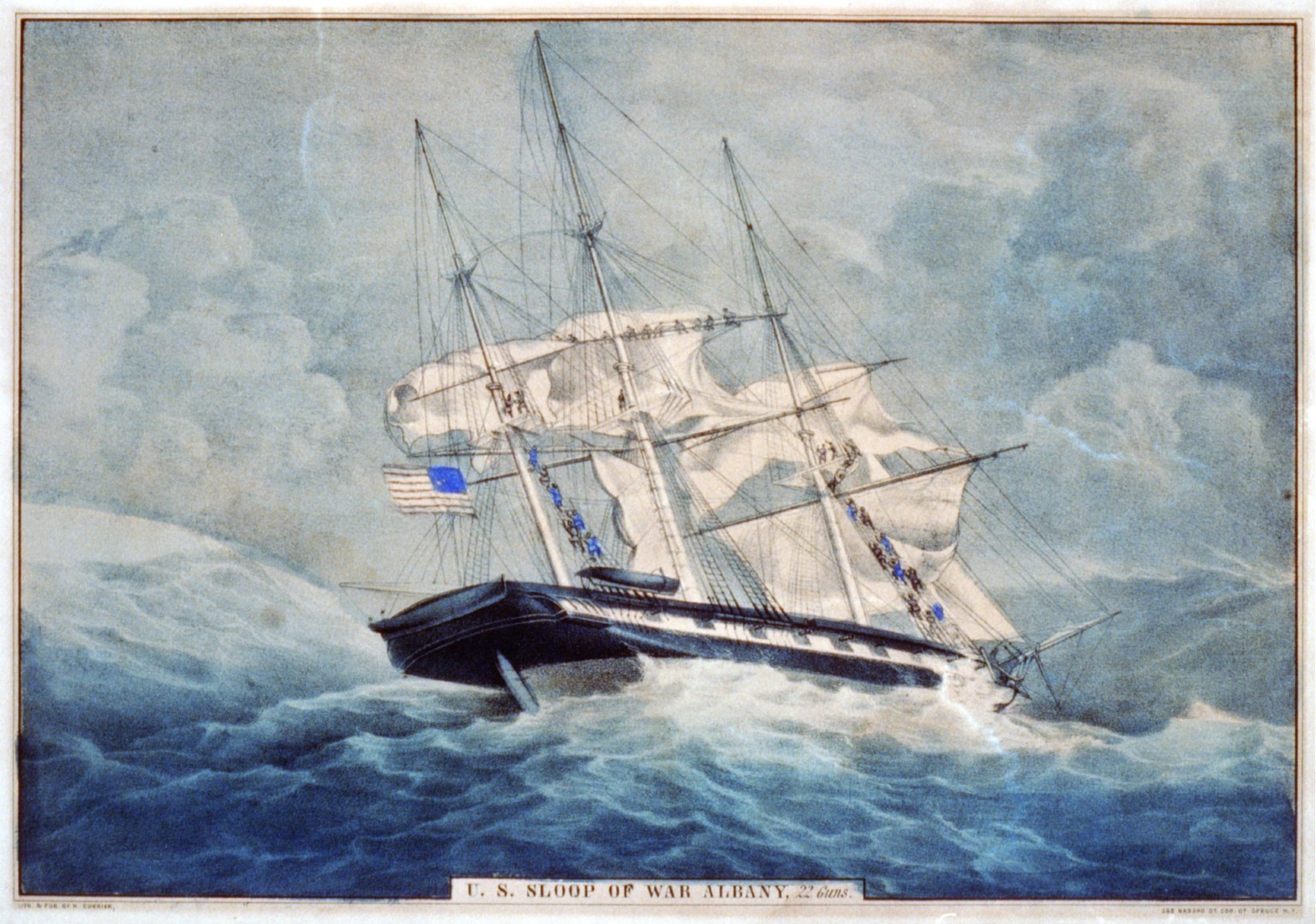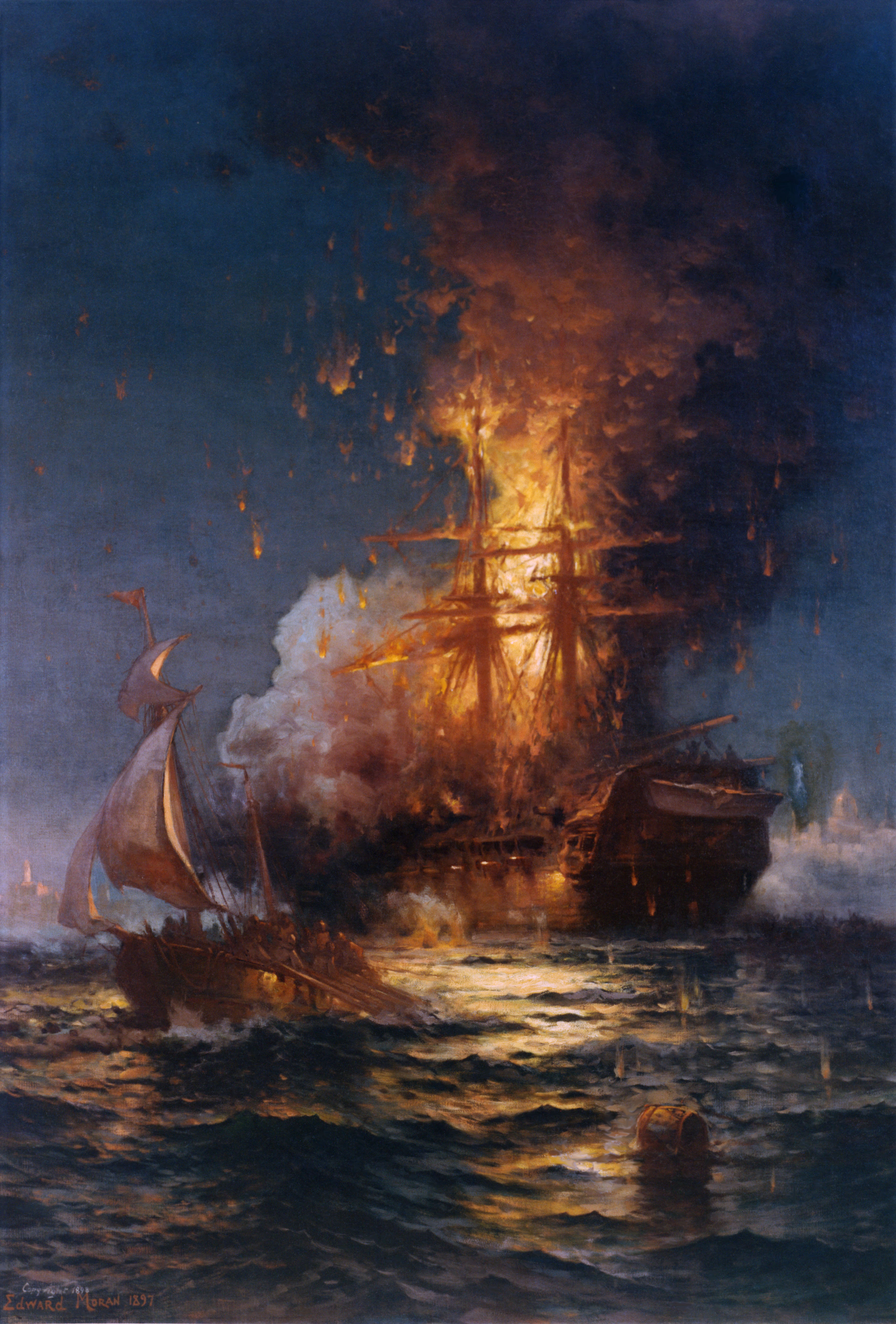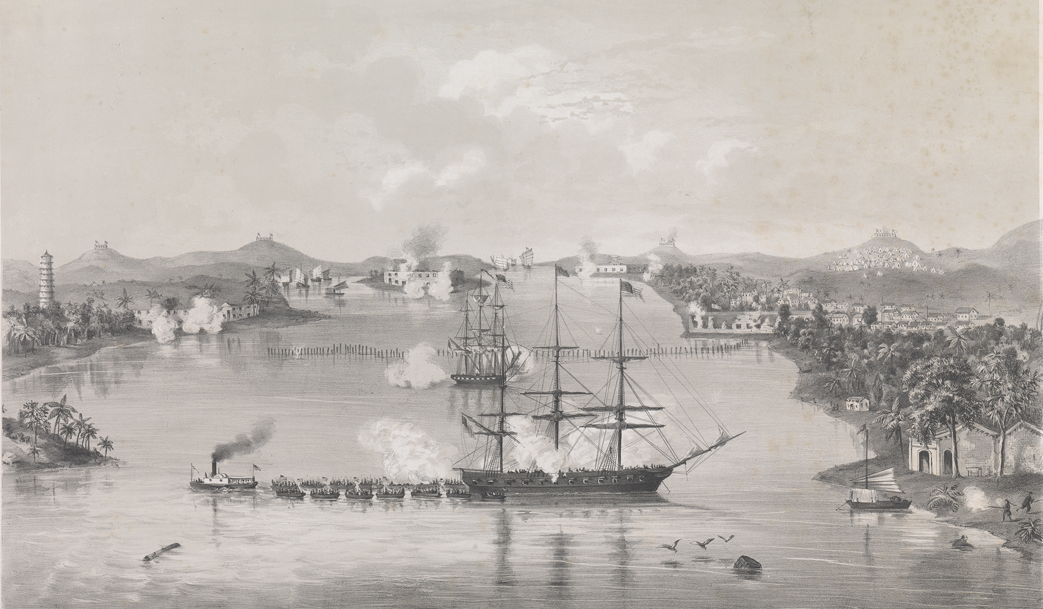|
Edward T. Nichols
Edward Tatnall Nichols (March 1, 1823October 12, 1886) was a United States Navy rear admiral. Career Nichols began his naval service by being appointed to the U.S. Navy from Georgia on December 14, 1836. He was first attached to the sloop USS ''Levant'' and served in the West Indies Squadron, 1837-1840. He attended the Philadelphia Naval School, 1841-1842. Nicholas passed as a midshipman July 1, 1842, and was assigned to the frigate USS ''Columbus'' in the Mediterranean Squadron serving until 1844. The following year, Nichols served aboard the steamer USS ''Colonel Harney'' in the Atlantic Fleet and transferred to the frigate USS ''Columbia'' in the Brazil Squadron where here served until 1847. He was transferred again in 1847 to the bomb brig USS ''Stromboli'' in the Home Squadron, serving with her crew in 1847 and 1848. In his last assignment as a midshipman, Nichols served aboard the frigate USS ''Savannah'' in the Pacific Squadron, 1849-1851. Nichols was commissio ... [...More Info...] [...Related Items...] OR: [Wikipedia] [Google] [Baidu] |
Augusta, Georgia
Augusta ( ), officially Augusta–Richmond County, is a consolidated city-county on the central eastern border of the U.S. state of Georgia (U.S. state), Georgia. The city lies across the Savannah River from South Carolina at the head of its navigable portion. Georgia's Georgia (U.S. state)#Major cities (2017), third-largest city after Atlanta and Columbus, Georgia, Columbus, Augusta is located in the Fall Line section of the state. According to the U.S. Census Bureau, Augusta–Richmond County had a 2020 population of 202,081, not counting the unconsolidated cities of Blythe, Georgia, Blythe and Hephzibah, Georgia, Hephzibah. It is the List of United States cities by population, 116th largest city in the United States. The process of consolidation between the City of Augusta and Richmond County, Georgia, Richmond County began with a 1995 referendum in the two jurisdictions. The merger was completed on July 1, 1996. Augusta is the principal city of the Augusta metropolitan area. In ... [...More Info...] [...Related Items...] OR: [Wikipedia] [Google] [Baidu] |
Mexican–American War
The Mexican–American War, also known in the United States as the Mexican War and in Mexico as the (''United States intervention in Mexico''), was an armed conflict between the United States and Mexico from 1846 to 1848. It followed the 1845 American annexation of Texas, which Mexico still considered its territory. Mexico refused to recognize the Velasco treaty, because it was signed by President Antonio López de Santa Anna while he was captured by the Texan Army during the 1836 Texas Revolution. The Republic of Texas was ''de facto'' an independent country, but most of its Anglo-American citizens wanted to be annexed by the United States. Sectional politics over slavery in the United States were preventing annexation because Texas would have been admitted as a slave state, upsetting the balance of power between Northern free states and Southern slave states. In the 1844 United States presidential election, Democrat James K. Polk was elected on a platform of expand ... [...More Info...] [...Related Items...] OR: [Wikipedia] [Google] [Baidu] |
USS Savannah (1842)
The second USS ''Savannah'' was a frigate in the United States Navy. She was named after the city of Savannah, Georgia. ''Savannah'' was begun in 1820 at the New York Navy Yard, but she remained on the stocks until 5 May 1842, when she was launched. She was one of nine frigates to be built from a prototype design by naval architect William Doughty. ''Savannah'', with Captain Andrew Fitzhugh in command, joined the Pacific Squadron as flagship in 1844. As the prospect of war with Mexico became imminent, the Squadron moved into position off the California coast. On 7 July 1846, the Squadron captured Monterey without firing a shot. On 8 September 1847, ''Savannah'' returned to New York for repairs. She served as flagship for the Pacific Squadron again from 1849–52. Repairs at Norfolk, Virginia took her into 1853, and on 9 August of that year, she sailed for a three-year cruise on the Brazil Station. In November 1856 she was inactivated, and in 1857, razeed, or reduced to a ... [...More Info...] [...Related Items...] OR: [Wikipedia] [Google] [Baidu] |
Home Squadron
The Home Squadron was part of the United States Navy in the mid-19th century. Organized as early as 1838, ships were assigned to protect coastal commerce, aid ships in distress, suppress piracy and the Atlantic slave trade, make coastal surveys, and train ships to relieve others on distant stations. It was discontinued in 1861 after the outbreak of the American Civil War, when the Union blockade forced a reassignment of ships to close off Southern ports. History Mexican–American War During the Mexican–American War the ships of the Home Squadron, commanded by Commodore David Conner, USN fought in several engagements against Mexican forces. Many of the Home Squadron vessels were attached to vice commander Commodore Matthew C. Perry's Mosquito Fleet which was involved in the battles of Tuxpan, Tabasco, Villahermosa and Veracruz. No ship-to-ship combat occurred though several merchant vessels were captured, the Home Squadron primarily operated against Mexican coastal forts a ... [...More Info...] [...Related Items...] OR: [Wikipedia] [Google] [Baidu] |
USS Stromboli (1846)
USS ''Stromboli'' was a bomb brig of the United States Navy used in the Mexican–American War. In 1846, the United States Navy purchased the brig ''Howard'' at Boston, Massachusetts to strengthen its forces for the Mexican–American War. Commissioned on 18 March 1847 ''Stromboli'', named for the island of Stromboli in the Tyrrhenian Sea, the ship sailed for the Gulf of Mexico under the command of Commander William S. Walker. ''Stromboli'' performed blockade duty in the Bay of Campeche, especially off the mouth of the Coatzacoalcos River. In mid-June, she sailed to the mouth of the Tabasco River. On 14 June, she and were towed across the bar into the river as Commodore Matthew Calbraith Perry's squadron occupied Frontera. The force then moved upstream and took Tabasco the following day. ''Stromboli'' later returned to blockade duty off the mouth of the Coatzacoalcos. That summer, the ship's crew was stricken by yellow fever, but she continued to help guard the U.S. Army ... [...More Info...] [...Related Items...] OR: [Wikipedia] [Google] [Baidu] |
USS Columbia (1836)
The first USS ''Columbia'' of the United States Navy to be commissioned was a three-masted, wooden-hulled sailing frigate, built at the Washington Navy Yard and carrying 54 guns (an earlier ''Columbia'' was destroyed during the burning of Washington in 1814 whilst it was still under construction). Her keel was laid in 1825, but as was typical of much Navy construction during this period, she was not launched until much later, on 9 March 1836. On her first cruise, from May 1838 – June 1840 with Lieutenant George A. Magruder in command, ''Columbia'' rounded the Cape of Good Hope to become flagship of Commodore George C. Read in the East India Squadron. She returned to the United States by way of Cape Horn, becoming one of the first U.S. naval ships to circumnavigate the globe. She participated in the 1838 Second Sumatran Expedition in response to a Maylay attack on an American merchant vessel. ''Columbia'' served as flagship of the Home Squadron from January–May 1842; cruise ... [...More Info...] [...Related Items...] OR: [Wikipedia] [Google] [Baidu] |
Mediterranean Squadron (United States)
The Mediterranean Squadron, also known as the Mediterranean Station, was part of the United States Navy in the 19th century that operated in the Mediterranean Sea. It was formed in response to the First and Second Barbary Wars. Between 1801 and 1818, the squadron was composed of a series of rotating squadrons. Later, squadrons were sent in the 1820s to the 1860s to suppress piracy, primarily in Greece and to engage in gunboat diplomacy. In 1865 the force was renamed the European Squadron. History First Barbary War The Barbary pirates' seizure of American merchant ships went back to just after the victory over Great Britain in 1783. When the Dey of Algiers demanded tribute, the Americans refused and thus began a long series of conflict between the Barbary states and the United States lasting from the 1780s to 1815. The Mediterranean Squadron was created for the protection of American merchant ships sailing in Mediterranean waters. The first squadron sent was under the command of ... [...More Info...] [...Related Items...] OR: [Wikipedia] [Google] [Baidu] |
USS Columbus (1819)
USS ''Columbus'' was a 92-gun ship of the line in the United States Navy. Although construction of the warship was authorized by Congress on 2 January 1813, plunder of the Washington Navy Yard by British troops in 1814 during the burning of Washington, combined with efforts to keep US military stores out of British hands, led to the destruction of any initial framing. Days after Congress re-authorized the vessel on 29 April 1816, a keel was laid and construction resumed. ''Columbus'' was launched on 1 March 1819 into the Anacostia River at the Washington Navy Yard; her dimensions were "191 feet 10 inches, between perpendiculars; breadth of beam from outside to outside, 53 feet 6 inches". The warship was commissioned on 29 November 1819, Master Commandant John H. Elton, commanding. Her original armament comprised "92 guns: 68 long 32-pounders and twenty-four 42-pounder carronades"; this was greater than the Naval artillery equipping most of the nine ships-of-the-line authorize ... [...More Info...] [...Related Items...] OR: [Wikipedia] [Google] [Baidu] |
Philadelphia Naval Asylum
The Philadelphia Naval Asylum is a complex of buildings at Gray's Ferry Avenue in Philadelphia, Pennsylvania. Built in 1827 as a hospital, it later housed the Philadelphia Naval School, served as a home for retired sailors for the United States Navy from 1834 to 1976, and was ultimately redeveloped as luxury condominiums. The site was placed on the National Register of Historic Places and designated a National Historic Landmark in 1971, primarily for its architecture. Set on more than , the campus includes three buildings designed by architect William Strickland that are considered some of the best examples of Greek Revival architecture in the United States: Biddle Hall (the 1833 main building), the surgeon's residence and the governor's residence. For seven years, from 1838 until 1845, the campus housed the Philadelphia Naval School, a precursor to the United States Naval Academy. Beginning in 1838, midshipmen approaching examinations for promotion were assigned to the school f ... [...More Info...] [...Related Items...] OR: [Wikipedia] [Google] [Baidu] |
West Indies Squadron (United States)
The West Indies Squadron, or the West Indies Station, was a United States Navy squadron that operated in the West Indies in the early nineteenth century. It was formed due to the need to suppress piracy in the Caribbean Sea, the Antilles and the Gulf of Mexico region of the Atlantic Ocean. This unit later engaged in the Second Seminole War until being combined with the Home Squadron in 1842. From 1822 to 1826 the squadron was based out of Saint Thomas Island until the Pensacola Naval Yard was constructed. Formation United States Navy ships had for years operated against piracy and the slave trade in the Caribbean and Gulf of Mexico but it was not until 1822 that a permanent squadron was formed. American warships were assigned to anti-piracy operations in the West Indies as early as 1817 but after a September 1821 attack by pirates, in which three American merchant ships were captured, the United States Congress authorized Commodore James Biddle to dispatch a fleet to the Caribb ... [...More Info...] [...Related Items...] OR: [Wikipedia] [Google] [Baidu] |
USS Levant (1837)
The first USS ''Levant'' was a second-class sloop-of-war in the United States Navy. ''Levant'' was launched on 28 December 1837 by New York Navy Yard; and commissioned on 17 March 1838, with Commander Hiram Paulding in command. Service history West Indies and Pacific, 1838–1845 ''Levant'' sailed from New York on 1 April 1838 for four years' service in the West Indies Squadron protecting American interests in the Caribbean and South Atlantic. Returning to Norfolk, Virginia, the sloop-of-war decommissioned 26 June 1842. She recommissioned 27 March 1843, Comdr. Hugh N. Page in command, and departed Norfolk to join the Pacific Squadron under Commodore John D. Sloat. From 1843 to 1845 ''Levant'' cruised between Panama and Latin American ports carrying diplomats and dispatches and generally furthering American national policy. Mexican–American War, 1846–47 With the Mexican–American War impending, ''Levant'' was ordered to the California coast to protect American citizens a ... [...More Info...] [...Related Items...] OR: [Wikipedia] [Google] [Baidu] |






